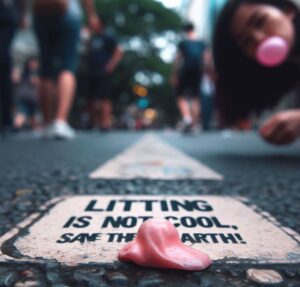Understanding the Cost of Chewing Gum Litter

Addressing the issue of chewing gum litter signifies grappling with a considerable financial burden — one that stretches the budget of local governments globally. Year on year, an enormous sum — running into millions — is allocated towards maintaining the cleanliness of our streets, sidewalks, and public spaces. A significant chunk of this expenditure can be attributed squarely to the problem of discarded gum.
The gum removal process itself is far from simple. Unlike other forms of trash that may be swept up or, at worst, picked up, removing gum from surfaces can prove to be a herculean task. Embedded into the surface, each piece of discarded gum necessitates a labor-intensive, time-consuming removal process. This process often calls for specialized equipment and techniques to thoroughly eliminate the sticky residues and restore surfaces to their former condition. Thermal Lance or Steam Cleaners, Gumpaks, Jet Washers, to name a few, are exclusively designed for this purpose, and their acquisition represents a significant investment for local authorities.
Yet, the costs do not stop there. These high-tech, specialized machines require continuous maintenance. The wear and tear from regular use, coupled with the rugged nature of gum removal, often result in frequent repairs and, in some cases, the need for complete machine replacement. This ongoing maintenance only adds to the financial burden, inflating the overall cost of fighting the gum litter issue.
Beyond the equipment and its maintenance, the human resource element further escalates the cost. The task of gum removal requires skilled labor — workers who are trained in the usage of specialized equipment and can efficiently rid public spaces of gum litter. These crews need to be employed across various shifts to ensure clean public spaces during all hours. Wages for these cleaning crews, along with the administrative costs of managing these teams, make up another substantial portion of the annual budget set aside for gum litter cleanup.
Understanding the cost of chewing gum litter helps us realize the magnitude of this often overlooked issue. The financial implications stretch beyond the visible and mold a challenge that grapples with multiple aspects of public administration, maintaining cleanliness, and managing public funds responsibly.
Impact on Local Businesses and Tourism
The impact of gum litter extends beyond cleanup costs. Locales strewn with gum litter present an aesthetic detraction affecting local businesses and tourism. Retail outlets, restaurants, and other organizations in such areas may see a decline in customers who prefer cleaner environments. Tourists are less likely to visit and recommend places where gum litter is rampant, with subsequent fallout for the local economy.
The Chewing Gum Litter Effect on Property Values
The issue of chewing gum litter has an insidious effect that extends far beyond just the aesthetic appeal of a region. It quietly but inevitably creeps into the economic realm, casting a negative impact on an asset highly valued in our society: real estate. Neighborhoods characterized by gum-infested sidewalks and public spaces suffer an economic setback. The depreciating property values in these areas are but a direct repercussion of the chewing gum litter problem.
The relationship between the condition of a neighborhood and the value of its real estate properties is deeply intertwined. Prospective home buyers and investors don’t only consider the square footage or the architectural design of a property; they also highly regard the cleanliness and maintenance of the surrounding area. An unsightly environment marred by gum litter is often perceived as a poorly managed locale. This lack of cleanliness gives an impression of neglect, and potential buyers may question the local governing bodies’ competency if such basic upkeep tasks are not met.
This perceived neglect associated with gum litter infested areas can reduce the wider neighborhood’s appeal. When evaluating a prospective location for a property purchase, buyers scrutinize aspects like accessibility to amenities, local educational facilities, connectivity, and, importantly, hygienic and well-kept surroundings. As gum litter degrades the aesthetic appeal and cleanness of an area, these neighborhoods lose out on the market competition, and their property values take a hit.
The ripple effect of depreciating property values due to gum litter affects not only individual property owners but also local economies. Lower property values mean a decreased property tax base, leading to lesser public fund collections. Consequently, this affects local administrations’ ability to provide quality public services, further catalyzing a cycle of degradation and decline in property values.
The chewing gum litter problem is more than just a cleanliness or environmental issue. It is a socio-economic dilemma that affects individuals’ wealth, influences local economies, and can carve out the trajectory of neighborhood development. Addressing this issue is, hence, vital for preserving the value of our built environment and overall community welfare.
Recycling and Reprocessing Costs

While chewing gum litter poses numerous problems, various recycling initiatives worldwide are now looking at it as a potential resource. These programs propose a practical solution by transforming the discarded gum into reusable products, which not only reduces litter but also contributes towards more sustainable practices. These recycling options are not without their hurdles – quite notably, the financial implications associated with the reprocessing costs.
The process of turning discarded gum into viable, reusable products necessitates an elaborate and costly setup. Recyclable products, such as walking shoes, toys, and even mobile phone covers have been created from recycled gum, but the transformation is far from straightforward. It involves the collection, sterilization, and reprocessing of the gum, all of which require specialized facilities and equipment. The associated costs for initiating such a reprocessing facility are substantial.
The operation and running costs of such facilities only add to the expense. These encompass the cost of energy, labor, materials used in the recycling process, and maintenance of the machinery involved. Irrespective of the size of the operation, these facilities must be sufficiently coordinated to ensure the reprocessing is effective, cost-efficient, and sustainable, which is an administrative expense in itself.
These recycling initiatives carry the potential to offset cleanup costs in the longer term, the high initial costs are often the main deterrent. Municipalities often find it hard to justify the substantial investments required for the setup and running of such facilities, especially when pitted against various other competing needs within a community’s limited budget. These capital-intensive recycling projects may seem financially daunting, and sometimes, their long-term benefits are overlooked.
While recycling and reprocessing of discarded gum present an environmentally friendly solution to the gum litter problem, it comes with its own set of challenges. There is a significant upfront investment involved, and although potentially profitable in the longer run, this outlay stands as a considerable obstacle for many municipalities contemplating such initiatives. If executed efficiently, these programs can have far-reaching benefits in terms of local employment generation, environmental protection, and long-term cost savings.
The Potential Economic Benefits of Solving the Issue
While addressing the issue of gum litter does come with its financial and logistical challenges, it often overlooks the broader economic benefits that can be reaped from the problem’s effective resolution. A successful intervention against the gum litter phenomenon presents a multifaceted economic opportunity that can result in tangible savings and indirect economic benefits.
One immediate advantage is the substantial savings that can be realized from reduced cleanup operations. Currently, municipalities worldwide spend millions annually to keep their pavements and public spaces free from stubborn gum residues. Once the issue of gum litter is effectively addressed, there’ll be a significant decrease in the resources – both financial and human – dedicated to cleanups. This saved money can then be channeled into more productive civic projects that can enhance community development and quality of life for the residents.
A comprehensive solution to the gum litter problem could open the door to an entirely new green industry dedicated to gum litter management. Innovative solutions to convert discarded chewing gum into reusable commercial products can lead to the establishment of recycling and processing facilities. The creation of such facilities means not only the inception of new businesses but also job creation in various roles – from collection and processing to marketing and sales.
An effectively managed and thriving gum recycling industry can also stimulate the economy indirectly. For instance, this industry can contribute to local revenue through business taxes. The products churned out from recycled gum can find a market not just domestically but also overseas, boosting exports and bringing in foreign currency.
Despite the immediate implications and costs associated with addressing the gum litter issue, the perspective should not be limited to these short-term hurdles. Instead, a forward-thinking approach would consider the potential long-term economic benefits that include savings on cleanup costs, job creation, income generation through a new industry, and potential export opportunities. Solving the gum litter problem could, surprisingly, turn out to be a ‘sticky’ economic opportunity if managed effectively and methodically.



